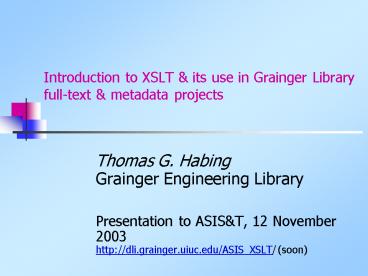Introduction to XSLT - PowerPoint PPT Presentation
1 / 19
Title:
Introduction to XSLT
Description:
Introduction to XSLT & its use in Grainger Library full-text & metadata projects ... Intro to XSLT at Grainger. 2. XSL Transformations (XSLT) ... – PowerPoint PPT presentation
Number of Views:457
Avg rating:3.0/5.0
Title: Introduction to XSLT
1
Introduction to XSLT its use in Grainger
Library full-text metadata projects
- Thomas G. HabingGrainger Engineering Library
- Presentation to ASIST, 12 November
2003http//dli.grainger.uiuc.edu/ASIS_XSLT/
(soon)
2
XSL Transformations (XSLT)
- XSLT 1.0 W3C Recommendation (16 November 1999)
- XSL FO 1.0 W3C Recommendation (15 October 2001)
- XSLT 2.0 W3C Working Draft (2 May 2003)
- Language for transforming XML to XML, HTML
- Map from one semantic scheme to another
(generally of equivalent or lesser granularity) - E.g., map
- ColeTim
- to
- Tim Cole
3
XSL Transformations (XSLT) 2
- Examples
- XML to XHTML
- MARC to Dublin Core
- ISO Math Markup to MathML
- Normalize collection of heterogeneous markup
- Extract subset of a complete document(s)
- Open multiple XML documents simultaneously
- Search across multiple XML documents
- Read XSD to decide how to transform an XML file
4
XSL Transformations (XSLT) 3
- Full-featured procedural programming language
- Flow control (e.g., looping conditional
branching) - Variables, input parameters supported
- Basic string manipulation, numeric calculations
- Modularity, calls to external functions,
recursion - External functions execute within constraints of
transforming XML parser being used - Single XML document as output (1.0)
5
XSL Transformations (XSLT) 4
- Implemented by transforming XML parsers
- Transforms can be done server or client side
- Newer browsers (IE5, Mozilla / Netscape 7)
- XSLT documents are themselves XML
- ,
- Valuable for interoperability or reusability
6
XML Path Language (XPath)
- XPath 1.0 W3C Recommendation (16 November 1999)
- XPath 2.0 W3C Working Draft (22 August 2003)
- Language for addressing parts of an XML file
- Data model for XML
- Includes tests, pattern matching
- Used in XSLT to access DOM elements
7
XML Path Language (XPath) 2
- XPath expressions evaluate to atomic values,
individual nodes, or collections of nodes - XPath is syntax for identify document nodes in
XSLT - //dctitle
- dcdc/dcsubject3
- dcdc/dc
- marcdatafield_at_tag100 marcdatafield_at_tag110
- marcdatafield_at_tag260/marcsubfield_at_code'c'
- .
- substring(dctitle,5,10)
8
XSLT Examples
- XSLT for Dublin Core XML to XHTML
- Ballads DC
- XSLT for MARC21 XML to HTML
- Ballads MARC
- XSLT for MARC21 XML to DC XML
- Ballads MARC to DC
- XSLT to search multiple DC XML files
- Search 5 DC Records
9
ZVON Tutorial
- http//www.zvon.org/xxl/XPathTutorial/General/exam
ples.html - http//www.zvon.org/xxl/XSLTutorial/Output/content
s.html
10
XSL Tools
- TIBCO XMLTransform
- MarrowSoft Xselerator
- Treebeard
- JAXP (Java XML Transforming Parser)
- MSXML SDK
- MSXSL (Command line transformer)
- EXSLT
11
XSLT Where Should It Happen
- Client-side
- IE5 or Mozilla
- IE5 not yet fully compliant w/ XSLT and XPath
standard - Can reduce the load on your servers
- But performance on low-end clients can be BAD
- Server-side
- Performance could be a problem on busy servers,
serving large, complex documents - More control and flexibility over the conversion
(metamerge) - Offline Preconversion
- Best performance
- Not good for dynamic documents (metamerge)
12
How We Use XSLT
- Most tags are converted to HTML spans with a
class attribute equal to the original tag
name,i.e. becomes -
selectlocal-name()/
- If the tag must be a block element, that is
specified in the CSS span.sect displayblock - This improves the modularity of the code
13
How We Use XSLT (cont.)
- Some tags require special conversion,i.e. type1 becomes
-
selectlocal-name()/_ select_at_type/
- CSS span.emph_1 font-styleitalic
span.emph_2 font-weightbold
14
How We Use XSLT (cont.)
- Some elements need to have punctuation added,
i.e.TomTimBob
becomes Tom, Tim, Bob. -
.
,32 ate
15
How We Use XSLT (cont.)
- Some elements need their children rearrangedi.e.
HabingTom becomes Tom
Habing - ate nameclass-attr/ selectfn/32 selectsn/
- Real DTDs can require some fairly complex
processing. - So far XSLT seems to be able to handle nearly
every case we have come across - However, some cases have required JScript
extensions to XSLT
16
How We Use XSLT (cont.)
- Some elements are converted into HTML elements
other than - Elements representing figures or images are
converted to the tag. - Elements representing internal links with ID and
IDREF attributes are usually converted into
name or tags. - Table elements are converted into corresponding
HTML , , or tags. - In all cases, a class attribute is added which is
the original XML tag name this is used in the
CSS.
17
XSLT Demos
- ASM Handbook
- article2.xsl
- asm_ie5_html.css
- Summary of Engineering Research
- SER2FO.xsl
- Dublin Core XML Schemas
- DCDD.xsl
- DCDD2.xsl
- test_dcterms.xml
- sampleDCDD2.xml
18
TEI and XSLT
- XSL stylesheets for TEI XML
- XSL TEI HTML stylesheet parameterization
19
Extreme XSLT
- http//fxsl.sourceforge.net/
- http//www.topxml.com/code/?p1ms10ldesignpatt
ernsswcateg - http//www.schematron.com/































